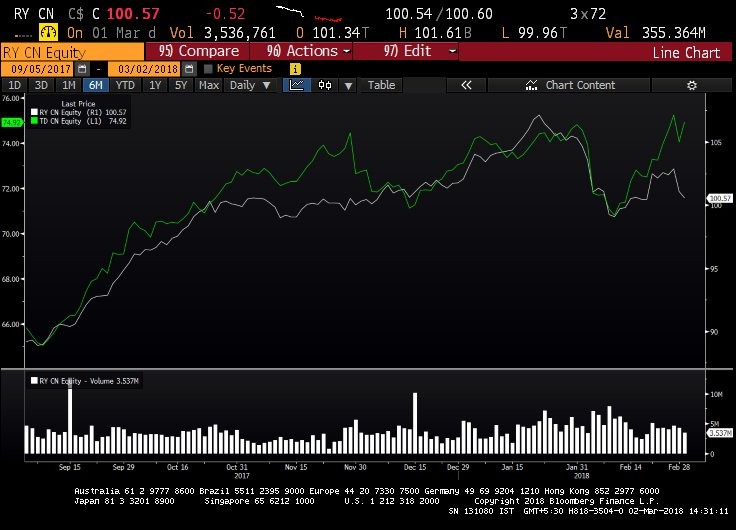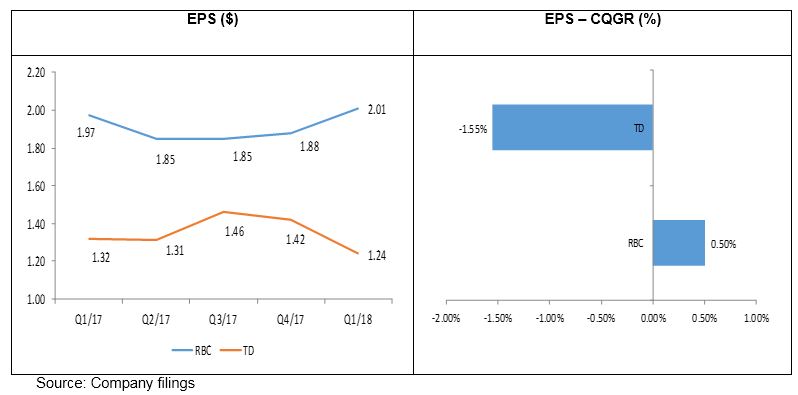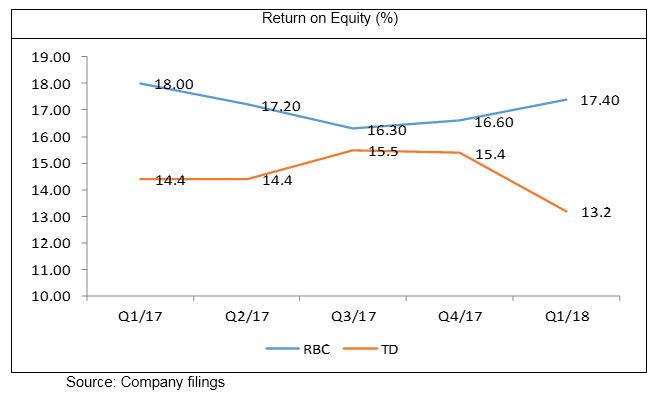Royal Bank of Canada (TSX:RY) outperformed TD Bank (TSX:TD) on metrics such as revenue growth, EPS growth, and Return on Equity
SmallCapPower | March 16, 2018: Royal Bank of Canada (TSX:RY) and TD Bank (TSX:TD) are two of the Big 5 banks in Canada. From a geographical standpoint, Royal Bank derives 61% of its revenue domestically, 23% from the U.S. and 16% internationally. On the other hand, TD derives 60% of its revenue from Canada, 35% from the United States, and the remaining 5% from the U.K. Both banks have posted consistent stock performance amidst a healthy revenue pick up in recent years.
To help investors make an informed decision before investing in either stock, we analyze the following key metrics: Historical Stock Movement, Revenue Growth, EPS Growth and Return on Equity.
Historical Stock Movement
During the past six months, shares of both Royal Bank of Canada and TD Bank have exhibited an upward trend on the back of healthy financial results. Royal Bank of Canada shares rose 12.7% while TD Bank slightly outperformed with an increase of 13.8%. As can be seen from the chart below, both stocks have moved in tandem except for the October – November 2017 timeframe, where TD outperformed its peer by a large margin. Source: Bloomberg
Source: Bloomberg
Revenue Growth
In Q1 2018, Royal Bank of Canada reported total revenue of $10.8 billion whereas TD Bank’s revenue came in at $9.4 billion. During the last five quarters, RY revenues have consistently beaten that of TD. On the basis of revenue growth, RY surpasses TD with a CQGR (compounded quarterly growth rate) of 2.93% vs. 0.65%.
EPS Growth
As the term suggests, Earnings per Share (EPS) is the portion of net income attributable to all common shareholders. For comparative analysis, diluted EPS is the most appropriate metric. For the quarter ending January 31, 2018, Royal Bank of Canada’s diluted EPS of $2.01 was significantly higher compared to TD Bank’s $1.24. As can be seen from the chart below, RY has reported positive EPS growth (CQGR) while TD has shown negative EPS growth (CQGR) in last five quarters.
Return on Equity
A key valuation metric while looking at bank stocks is Return on Equity (ROE). ROE is a measure of how efficiently the company generates profit from the shareholders’ invested capital. The chart below clearly illustrates that RY has a more attractive ROE profile relative to TD.
Conclusion
Although TD shares have performed slightly better than Royal Bank of Canada over the past six months, the latter outperforms the former on key financial metrics such as revenue growth, EPS growth, and Return on Equity. Thus, RBC shares look poised for a stronger performance in 2018.
Disclosure: Neither the author nor his family own shares in any of the companies mentioned above.
To read our full disclosure, please click on the button below:



